Read more Articles
Keep up to date with medspa marketing strategies.

In 2026, the digital landscape for MedSpas has shifted. It is no longer enough to simply "run ads" and hope for the best. Generating high-ticket medical leads now requires a high-intent acquisition strategy that matches specific service types to the correct advertising platforms.
Success in the current market depends on three pillars: a minimum monthly test budget of $1,500, an automated qualification pipeline (using a CRM like GoHighLevel), and a shift in focus from "lead volume" to "consultation quality."
A medical lead is an individual who has signaled interest by sharing their contact information. However, a lead is not a patient. Many clinic owners grow frustrated when leads don't book immediately, but in 2026, the lead is simply the start of a conversation.
Intent, Financial Readiness, and Urgency define high-quality leads. Your marketing system’s job is to filter out the "window shoppers" so your front desk only spends time on patients ready to commit to high-ticket plans.
Precision is the key to ROI. Are you looking to launch a new service, like EmpowerRF, or are you trying to maintain a steady flow for foundational treatments like Neurotoxins?
Your choice of platform should be dictated by the "Buyer’s Journey" stage of the service:
The biggest reason MedSpa campaigns fail isn't the creative—it's the lack of data and infrastructure.
To allow the platform’s AI (the Pixel) to learn who your ideal patient is, we recommend a minimum monthly budget of $1,500. * The "Data Threshold": Lower budgets take months to "optimize," meaning you waste money on trial and error.
Standard EHRs are excellent for HIPAA-compliant charting, but they are notoriously bad at marketing. You need a Marketing CRM (like GoHighLevel) to act as the "brain" of your clinic. A CRM allows you to track lead sources, automate text-back sequences, and manage your sales pipeline in real-time.
Platforms have tightened restrictions on medical terms. To stay compliant while remaining effective:
Speed-to-lead is the #1 predictor of conversion. If you don't respond within 5 minutes, the lead has already moved on to your competitor.
In a world of spam, personalization and visual proof are your best friends.
Stop looking at "Cost Per Lead" as your only success metric. To scale your clinic, monitor:
Q: Why are my Facebook leads not answering the phone? A: This is usually due to "Low Friction." Meta makes it too easy to fill out a form. Adding a custom question to your Lead Form or using an automated SMS "Gatekeeper" will filter out accidental clicks.
Q: Should I offer a discount to get more leads? A: Discounts attract "price shoppers." Instead of a discount, offer Value-Add Packages. For example, "Book a Sculpt session and receive a complimentary medical-grade skincare consultation." This attracts high-ticket patients who value results over the lowest price.
Q: Can I run ads for Weight Loss (GLP-1) in 2026? A: Yes, but with caution. These services are highly regulated. You must focus on the "Wellness Journey" and "Medical Supervision," rather than promising specific weight-loss results, to avoid being flagged for "unrealistic expectations."
Generating leads is a technical task; generating high-ticket revenue is a science. If you’re ready to stop guessing and start filling your calendar with vetted consultations, let’s build your 2026 growth flywheel together.
We build predictable patient acquisition systems that deliver real, trackable ROI for medspas.
Keep up to date with medspa marketing strategies.

